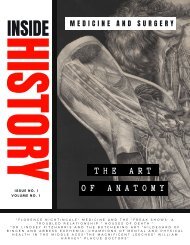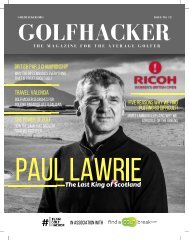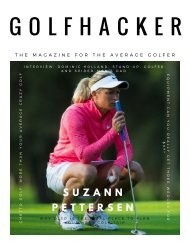InsideHistoryDigital
Create successful ePaper yourself
Turn your PDF publications into a flip-book with our unique Google optimized e-Paper software.
helped elevate the twins’ show. Indeed, from the<br />
1840s the freak show would become a respectable<br />
family affair attracting everyone from Queen<br />
Victoria to working-class men, women and<br />
children.<br />
On the other hand, medicine benefited from<br />
associating with Chang and Eng. The public were<br />
still sceptical of surgeons, so the medical<br />
endorsements were an exercise in public relations:<br />
surgeons were associating with the popular freak<br />
show and demonstrating an ability to view and<br />
inspect, not steal and dissect, the exceptional body<br />
(important when surgeons were renowned for<br />
relying on the dreaded body snatchers). And a<br />
relationship with the freak show meant access to<br />
the ‘freak’ body. There was a long tradition of<br />
surgeons getting their hands on the corpses of<br />
freak performers: the cadavers of the so-called Irish<br />
Giant Charles Byrne and the Sicilian Fairy Caroline<br />
Crachami found their way to the RCS, while the<br />
managers of Chang and Eng carried embalming<br />
fluid to preserve their corpses in case of sudden<br />
death. (3)<br />
Such was the friendliness between the medics and<br />
the managers that the surgeon George Bolton, a<br />
member of the RCS, could examine the twins<br />
intimately during their seven-month stay in<br />
London. Bolton delivered a report to his colleagues<br />
in April 1830, relaying how he had tested the<br />
sensitivity of the twins’ connecting band by poking<br />
it with a pin; he fed Chang an asparagus and sniffed<br />
the twins’ urine to decipher their ‘sanguineous<br />
communication’; and he even examined the twins’<br />
genitals, which they particularly resented.<br />
Nonetheless, Bolton could praise their ‘owners’<br />
(merchants who had effectively purchased the<br />
twins) for ‘the liberal manner in which they have<br />
uniformly afforded the means of investigating so<br />
curious an object of philosophical inquiry’.(4) The<br />
medical world and the freak show were happily<br />
united.<br />
But fast forward towards the end of the century.<br />
Chang and Eng had transitioned from freak<br />
performers to American farmers, fathers and<br />
slaveowners in the South (they had 21 children<br />
between them and were committed slaveowners).<br />
They continued to tour intermittently, displaying<br />
their offspring to gawping crowds, but the twins<br />
remained more concerned about their plantations<br />
in North Carolina than they did about their freak<br />
show careers. In 1874 the twins died aged sixty-two<br />
and, despite protestations from the family, the men<br />
of science finally got their sweaty palms on the<br />
corpses: Chang and Eng were dissected and their<br />
conjoined livers were displayed at the Mütter<br />
Museum in Philadelphia, where they can still be<br />
seen today.<br />
Medicine was increasingly colonising and<br />
controlling the ‘freak’ body. Indeed, Joseph Merrick,<br />
famously known as The Elephant Man, was taken<br />
from the freak show and contained within the<br />
London Hospital from 1884 until his dying days,<br />
under the careful watch of the eminent surgeon<br />
Frederick Treves. He condemned the freak show<br />
and Merrick’s London manager but, paradoxically,<br />
the surgeon became the showman: Treves<br />
exhibited Merrick at the Pathological Society of<br />
London; he controlled who saw, photographed and<br />
examined Merrick; and he capitalised on his<br />
association with The Elephant Man. When Merrick<br />
died in 1890, his body was handed over to Treves<br />
who dissected Merrick and arranged his skeleton<br />
for display in the Pathological Museum which,<br />
according to a contemporary surgeon, was ‘little<br />
better than a freak-museum’. (5)<br />
By the twentieth century, the rise of eugenics and<br />
social Darwinism led to a medical condemnation of<br />
freak shows which, it was increasingly believed,<br />
peddled physical deformity that threatened the<br />
nation’s health. The enigma of exceptional bodies<br />
was uncovered by the discovery of the endocrine<br />
system, ductless glands that regulate growth and<br />
secondary sexual functions; the X-Ray further<br />
exposed the inner realities of outward deformities.<br />
(6)<br />
Science was pathologizing the freak, killing the<br />
onstage mystique that had once been an essential<br />
part of the freak’s appeal. And freak performers<br />
increasingly went from the circuses and music halls<br />
to the laboratories and asylums as science gave the<br />
freak show a kiss of death.<br />
However, with shows like Embarrassing Bodies and<br />
documentaries peddling unusual bodies, the<br />
relationship between medicine and freakery<br />
lingers. Reality TV and programmes like The<br />
Undateables continue to rely on spectacle,<br />
titillation and voyeurism. Science might have<br />
marginalised the freak show in popular culture but<br />
remnants remain.<br />
The show, as they say,<br />
must go on.

















